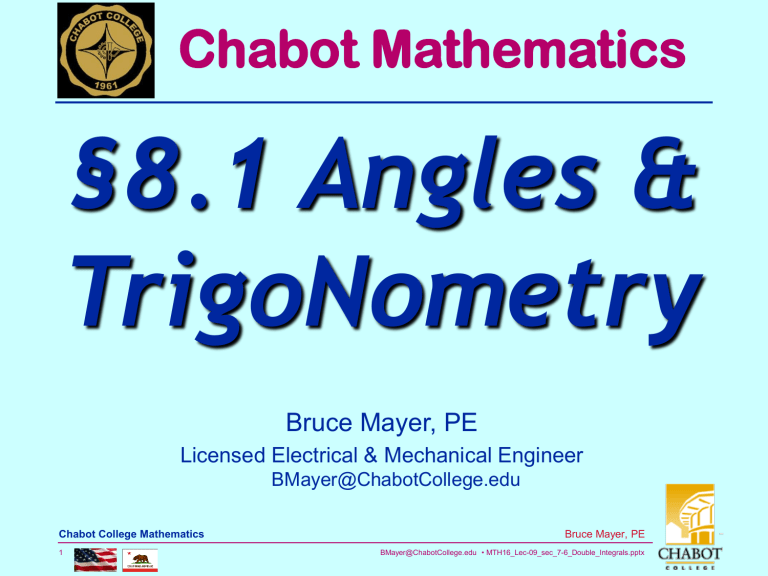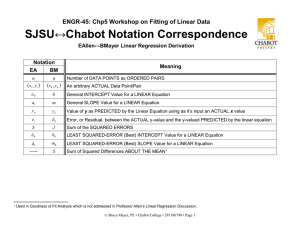§8.1 Angles & TrigoNometry Chabot Mathematics Bruce Mayer, PE
advertisement

Chabot Mathematics
§8.1 Angles &
TrigoNometry
Bruce Mayer, PE
Licensed Electrical & Mechanical Engineer
BMayer@ChabotCollege.edu
Chabot College Mathematics
1
Bruce Mayer, PE
BMayer@ChabotCollege.edu • MTH16_Lec-09_sec_7-6_Double_Integrals.pptx
Review §
7.6
Any QUESTIONS About
• §7.6 → Double Integrals
Any
QUESTIONS
About
HomeWork
• §7.6 → HW-9
Chabot College Mathematics
2
Bruce Mayer, PE
BMayer@ChabotCollege.edu • MTH16_Lec-09_sec_7-6_Double_Integrals.pptx
Angles: Basic Terms
Two distinct points determine a line
called
A
B
Line AB
Line segment AB → a portion of the
line between A and B, including points A
A
B
and B.
Ray AB → a portion of line AB that
starts at A and continues through B, and
on past B
A
B
Chabot College Mathematics
3
Bruce Mayer, PE
BMayer@ChabotCollege.edu • MTH16_Lec-09_sec_7-6_Double_Integrals.pptx
Angles: Basic Terms
Angle: formed by
rotating a ray around
its endpoint.
The ray in its initial
position is called the
initial side of the
angle
The ray in its location
after the rotation is the
terminal side of the
angle
Chabot College Mathematics
4
Bruce Mayer, PE
BMayer@ChabotCollege.edu • MTH16_Lec-09_sec_7-6_Double_Integrals.pptx
Identifying Angles
Unless it is ambiguous as to the meaning, angles
may be named only by a single letter (English or
Greek) displayed at vertex or in area of rotation
between initial and terminal sides
Angles may also be named by three letters, one
representing a point on the initial side, one
representing the vertex and one representing a point
on the terminal side (vertex letter in the middle,
others first B
or last)
Acceptable Names :
Chabot College Mathematics
5
c
angle A
angle
angle CAB
angle BAC
Bruce Mayer, PE
BMayer@ChabotCollege.edu • MTH16_Lec-09_sec_7-6_Double_Integrals.pptx
Positive & Negative Angles
Positive angle: The
rotation of the
terminal side of an
angle
counterclockwise.
Positive Angle
Chabot College Mathematics
6
Negative angle:
The rotation of the
terminal side is
clockwise.
Negative Angle
Bruce Mayer, PE
BMayer@ChabotCollege.edu • MTH16_Lec-09_sec_7-6_Double_Integrals.pptx
Angle: Measures & Classes
The most common unit for measuring
angles is the degree (°)
• One Rotation or Cycle = 360°
Four Classes of Angle:
• Acute, Right, Obtuse, Straight
0o 90o
Chabot College Mathematics
7
90 o
90o 180o
180o
Bruce Mayer, PE
BMayer@ChabotCollege.edu • MTH16_Lec-09_sec_7-6_Double_Integrals.pptx
Angle: RADIAN Measure
Define the “Radian” measure as the
SubTended Circumferential distance on
a circle divided by the radius.
Thus a subtended
angle that produces an
arc-length of 1 radius is
1 radian in measure
Radians in
Circle Circumfere nce 2r
one Cycle:
2
Circle Radius
Chabot College Mathematics
8
r
Bruce Mayer, PE
BMayer@ChabotCollege.edu • MTH16_Lec-09_sec_7-6_Double_Integrals.pptx
Degrees & Radians Compared
Measure
2
radians 90
Graphic
One Quarter
Revolution
radians 180
One Half
Revolution
3
radians 270
2
Three Quarter
Revolution
2 radians 360
One Full
Revolution
Chabot College Mathematics
9
Description
Bruce Mayer, PE
BMayer@ChabotCollege.edu • MTH16_Lec-09_sec_7-6_Double_Integrals.pptx
Degrees ↔ Radians
The Measure of One Cycle
360 One Cycle 2 rads
Then the Number “1”
One Cycle
One Cycle
360
2 rads
180
rads
Convert to other Measure: 53°, 2.2 rad
rads
53 1 53
0.925 rad
180
180
2.2 rad 1 2.2 rad
126.05
rads
Chabot College Mathematics
10
Bruce Mayer, PE
BMayer@ChabotCollege.edu • MTH16_Lec-09_sec_7-6_Double_Integrals.pptx
Unit Circle
Imagine a circle on
the CoOrdinate
plane, with its center
at the origin, and a
radius of 1.
Choose a point on
the circle
somewhere in
quadrant I.
Chabot College Mathematics
11
Bruce Mayer, PE
BMayer@ChabotCollege.edu • MTH16_Lec-09_sec_7-6_Double_Integrals.pptx
Unit Circle
Connect the origin
to the point, and
from that point drop
a perpendicular to
the x-axis.
This creates a right
triangle with
hypotenuse of 1.
Chabot College Mathematics
12
Bruce Mayer, PE
BMayer@ChabotCollege.edu • MTH16_Lec-09_sec_7-6_Double_Integrals.pptx
Unit Circle
The length of its legs
are the x and y
coordinates of the
chosen point.
Applying the
definitions of the
trigonometric ratios
to this triangle gives
Opp y
sin
y
Hyp 1
Chabot College Mathematics
13
is the
angle of
rotation
1
y
x
Adj x
cos
x
Hyp 1
Bruce Mayer, PE
BMayer@ChabotCollege.edu • MTH16_Lec-09_sec_7-6_Double_Integrals.pptx
Unit Circle
Thus The CoOrdinates of the chosen
point are the CoSine (x) and Sine (y) of
the angle
• This provides a way to define functions
sin() and cos() for all real numbers
cos x
sin y
• The Four other
Opp y
tan
trigonometric
Adj x
functions can be cot Adj x
Opp y
defined from the
Unit Circle as well
Chabot College Mathematics
14
Hyp
Adj
Hyp
csc
Opp
sec
Bruce Mayer, PE
BMayer@ChabotCollege.edu • MTH16_Lec-09_sec_7-6_Double_Integrals.pptx
1
x
1
y
The 16-Point Unit Circle
Chabot College Mathematics
15
Bruce Mayer, PE
BMayer@ChabotCollege.edu • MTH16_Lec-09_sec_7-6_Double_Integrals.pptx
sin
cos
tan
csc
sec
cot
16
1
3 /2
2 /2
BMayer@ChabotCollege.edu • MTH16_Lec-09_sec_7-6_Double_Integrals.pptx
Unit Circ Tabulated
0
1
1/2
3 /3
2
2 3 /3
3
1
1
2 /2
2
2
3 /2 1/2 3
3 /3
2 3 /3 2
0
1
1 0
1/2 3
2 3 /3 2 3 /3
3 /2
2 /2
1
2 /2
1 2 2
3 /2 3 /3 2 2
1/2
3 /3 3
0 1 0 1
2
1/2
2 3 /3
3
3
/2
3
/3
1
2
1
2 /2 2
2 /2
3 /3 2
3 /3
1/2 3 2
3 /2
0
1 0 1
3 /2 1/2 3 2 3 /3 2 3 /3
2
2
2
/2
2
/2
1
1
1/2 3 /2
3 /3 2 2 3 / 3 3
1
Mayer, PE
Bruce
Chabot College Mathematics
1
0
0
0
Example Calc Sin & CoSin
Find the
u cos 2 and v sin 5 4
values:
Negative angles are represented by
traversing the Unit Circle ClockWise, so the
terminal side of an angle of −π/2 rads (−90°)
falls on the negative y-axis and takes the
point (1,0) to the point (0,−1).
The CoSine is given
by the x-coordinate
at this point, so
cos 2 u 0
Chabot College Mathematics
17
Bruce Mayer, PE
BMayer@ChabotCollege.edu • MTH16_Lec-09_sec_7-6_Double_Integrals.pptx
Example Calc Sin & CoSin
SOLUTION: v sin 5 4
The terminal side of the angle with
measure 5π/4 rads (225°) falls on the
line in the third quadrant which takes
the point (1,0) to the point:
x, y cos , sin
2
2
The Sine is the
y-coordinate
of this point, so
v sin 5 4 v 2 2
Chabot College Mathematics
18
,
2
2
Bruce Mayer, PE
BMayer@ChabotCollege.edu • MTH16_Lec-09_sec_7-6_Double_Integrals.pptx
Graph: Sine & CoSine
MTH16 • sin()
y = sin()
1
0.5
0
-0.5
-1
-10
-5
0
5
10
5
10
x
MTH16 • cos()
y = cos()
1
0.5
0
-0.5
-1
-10
-5
0
Chabot College Mathematics
x
19
BMayer@ChabotCollege.edu • MTH16_Lec-09_sec_7-6_Double_Integrals.pptx
Bruce Mayer, PE
Properties of Sine & CoSine
MTH16 • sin()
1
y = sin()
From the Periodic
Nature of the
Sinusoidal Graphs
Observe
sin sin
0
-0.5
-1
sin 2 sin
-10
-5
0
20
10
5
10
MTH16 • cos()
1
0.5
0
-0.5
-1
-10
-5
0
x
cos cos
Chabot College Mathematics
5
x
y = cos()
cos 2 cos
0.5
Bruce Mayer, PE
BMayer@ChabotCollege.edu • MTH16_Lec-09_sec_7-6_Double_Integrals.pptx
Chabot College Mathematics
21
Bruce Mayer, PE
BMayer@ChabotCollege.edu • MTH16_Lec-09_sec_7-6_Double_Integrals.pptx
MATLAB Code
% Bruce Mayer, PE
% MTH-16 • 22Feb14
% MTH15_Quick_Plot_BlueGreenBkGnd_130911.m
%
clear; clc; clf; % clf clears figure window
%
% The Domain Limits
xmin = -4*pi; xmax = 4*pi;
% The FUNCTION **************************************
x = linspace(xmin,xmax,1000); y = sin(x); y1 = cos(x);
% ***************************************************
% the Plotting Range = 1.05*FcnRange
ymin = min(y); ymax = max(y); % the Range Limits
R = ymax - ymin; ymid = (ymax + ymin)/2;
ypmin = ymid - 1.025*R/2; ypmax = ymid + 1.025*R/2
%
% The ZERO Lines
zxh = [xmin xmax]; zyh = [0 0]; zxv = [0 0]; zyv = [ypmin*1.05 ypmax*1.05];
%
% the 6x6 Plot
axes; set(gca,'FontSize',12);
whitebg([0.8 1 1]); % Chg Plot BackGround to Blue-Green
subplot(2,1,1)
plot(x,y, 'LineWidth', 4),grid, axis([xmin xmax ypmin ypmax]),...
xlabel('\fontsize{14}x'), ylabel('\fontsize{14}y = sin(\theta)'),...
title(['\fontsize{16}MTH16 • sin(\theta)'])
hold on
plot(zxv,zyv, 'k', zxh,zyh, 'k', 'LineWidth', 2)
hold off
subplot(2,1,2)
plot(x,y1, 'LineWidth', 4),grid, axis([xmin xmax ypmin ypmax]),...
xlabel('\fontsize{14}x'), ylabel('\fontsize{14}y = cos(\theta)'),...
title(['\fontsize{16}MTH16 • cos(\theta)',])
hold on
plot(zxv,zyv, 'k', zxh,zyh, 'k', 'LineWidth', 2)
hold off
Trig Fcn RelationShips
4 of the 6 Trig Functions can be
expressed in Terms of the basis
functions of sin and cos
With reference to the Unit Circle Find
y sin
x cos
tan
cot
x cos
y sin
1
1
sec
x cos
Chabot College Mathematics
22
1
1
csc
y sin
Bruce Mayer, PE
BMayer@ChabotCollege.edu • MTH16_Lec-09_sec_7-6_Double_Integrals.pptx
Pythagorean Identities
x, y
cos , sin
ReCall the
Pythagorean
Theorem
x 2 y 2 12
cos 2 sin 2 1
2
y2
y2 x2
y
tan 1 1 2 1 2 2
x
x
x
x
2
The Unit Circle
Analogy
Chabot College Mathematics
23
y 2 x 2 12 1
2
sec
2
2
x
x
x
2
Bruce Mayer, PE
BMayer@ChabotCollege.edu • MTH16_Lec-09_sec_7-6_Double_Integrals.pptx
Pythagorean Identities
Also
2
x
x2 y2 x2
1 cot 1 1 2 2 2
y
y
y
y
x, y
2
2
1
y x
1
2
csc
2
2
y
y
y
2
2
2
cos , sin
In Summary
sin 2 cos 2 1
tan 2 1 sec 2
1 cot 2 csc 2
Chabot College Mathematics
24
Bruce Mayer, PE
BMayer@ChabotCollege.edu • MTH16_Lec-09_sec_7-6_Double_Integrals.pptx
Example Use Trig Relns
Find the value of cos(θ) given that
• csc(θ) = 3
• the angle θ is contained in a right triangle
SOLUTION:
Recall from Unit Circle:
1
1
1
1
csc
csc 3
sin
y sin
13
3
Next use the Pythagorean Identity
cos 2 1 sin 2
Chabot College Mathematics
25
cos 2 1 1 3
2
Bruce Mayer, PE
BMayer@ChabotCollege.edu • MTH16_Lec-09_sec_7-6_Double_Integrals.pptx
Example Use Trig Relns
Then in
9 1 8
2
cos
This case
9 9 9
So
8
8
8
42
4 2
2 2
cos
9
9
3
3
3
9
2
But since θ is confined to right triangle θ
must be less than 90° then the cos must
be POSITIVE
Thus if
2 2
0.9428
csc(θ) = 3, cos
3
then
Chabot College Mathematics
26
Bruce Mayer, PE
BMayer@ChabotCollege.edu • MTH16_Lec-09_sec_7-6_Double_Integrals.pptx
Example Sinusoidal Periodicity
A math Model for the Diurnal hours of
daylight t months after January 1 in
Eugene, Oregon
Dt 3.17 sin 0.54t 1.51 12.2
Use this model to
• Find the amplitude, period, horizontal
and vertical shifts of the function.
– Interpret the values
Chabot College Mathematics
27
Bruce Mayer, PE
BMayer@ChabotCollege.edu • MTH16_Lec-09_sec_7-6_Double_Integrals.pptx
Example Sinusoidal Periodicity
SOLUTION:
The amplitude is the distance from
average to high (or average to low)
values of the function. This is
represented by the absolute value of
the CoEfficient on the trigonometric
function (sine in this case).
Dt 3.17 sin 0.54t 1.51 12.2
amplitude
Chabot College Mathematics
28
Bruce Mayer, PE
BMayer@ChabotCollege.edu • MTH16_Lec-09_sec_7-6_Double_Integrals.pptx
Example Sinusoidal Periodicity
Thus by the sinusoidal amplitude over
time, the daylight hours in Eugene
varies 3.17 up & down from its average.
SOLUTION:
The period of a sine function is the
value p when written in the form
2
x d
f x a b sin
p
Chabot College Mathematics
29
Bruce Mayer, PE
BMayer@ChabotCollege.edu • MTH16_Lec-09_sec_7-6_Double_Integrals.pptx
Example Sinusoidal Periodicity
Factor to produce a t-CoEfficient of this
form in the given function-argument:
0.54t 1.51 0.54t 2.80
Then by sine-argument Correspondence
2
2
0.54
p
11.64
p
0.54
The function repeats itself every 11.64
months, which is probably a rough
approximation of the 12-month yearly
cycle of daylight
Chabot College Mathematics
30
Bruce Mayer, PE
BMayer@ChabotCollege.edu • MTH16_Lec-09_sec_7-6_Double_Integrals.pptx
Example Sinusoidal Periodicity
SOLUTION:
The horizontal shift (also called the
Phase-Shift) of the function is given by
the value of d in the form
2
x d
f x a b sin
p
Again by sine-argument Correspondence
t 2.80
Chabot College Mathematics
31
x d
d 2.80
Bruce Mayer, PE
BMayer@ChabotCollege.edu • MTH16_Lec-09_sec_7-6_Double_Integrals.pptx
Example Sinusoidal Periodicity
The d = 2.8 months suggests that the
average value is not achieved at t = 0
(December 31st), but rather the function
is close to its minimum in early spring,
about 2.8 months in to the Year.
SOLUTION:
The vertical shift (also called the mean
value) of the function is given by the
value of a in the form
Chabot College Mathematics
32
Bruce Mayer, PE
BMayer@ChabotCollege.edu • MTH16_Lec-09_sec_7-6_Double_Integrals.pptx
Example Sinusoidal Periodicity
2
x d
f x a b sin
p
Then by function Correspondence
2
x d a 3.17 sin 0.54t 1.51 12.2 a 12.2
b sin
p
The function does not vary equally above
and below zero (negative daylight hours
makes no sense). Instead, the average
value is 12.2 hours and the function
varies up and down from that midline.
Chabot College Mathematics
33
Bruce Mayer, PE
BMayer@ChabotCollege.edu • MTH16_Lec-09_sec_7-6_Double_Integrals.pptx
WhiteBoard Work
Problems From §8.1
• P8.1-68 →
Home
Heating
Energy
Use in
Buffalo,
NewYork
Chabot College Mathematics
34
2010 Weather Summary
Buffalo, NY New York
Weather Index
22
29
Hail Index
3
39
Hurricane Index
34
93
Tornado Index
40
33
Annual Maximum Avg. Temperature
56.0 °F
57.0 °F
Annual Minimum Avg. Temperature
40.0 °F
39.0 °F
Annual Avg. Temperature
47.7 °F
47.7 °F
Annual Heating Degree Days (Tot Degrees < 65)
6,747
6,762
Annual Cooling Degree Days (Tot Degrees > 65)
477
484
Percent of Possible Sunshine
48
51
Mean Sky Cover (Sunrise to Sunset - Out of 10)
7
7
Mean Number of Days Clear (Out of 365 Days)
54
65
Mean Number of Days Rain (Out of 365 Days)
169
150
Mean Number of Days Snow (Out of 365 Days)
26
21
Avg. Annual Precipitation (Total Inches)
39.00"
38.00"
Avg. Annual Snowfall (Total Inches)
91.00"
75.00"
Bruce Mayer, PE
BMayer@ChabotCollege.edu • MTH16_Lec-09_sec_7-6_Double_Integrals.pptx
USA
100
100
100
100
N/A
N/A
N/A
N/A
N/A
N/A
N/A
N/A
N/A
N/A
N/A
N/A
All Done for Today
More
Trig
Identities
Chabot College Mathematics
35
Bruce Mayer, PE
BMayer@ChabotCollege.edu • MTH16_Lec-09_sec_7-6_Double_Integrals.pptx
Chabot Mathematics
Appendix
r s r s r s
2
2
Bruce Mayer, PE
Licensed Electrical & Mechanical Engineer
2a
–
Chabot College Mathematics
36
BMayer@ChabotCollege.edu
2b
Bruce Mayer, PE
BMayer@ChabotCollege.edu • MTH16_Lec-09_sec_7-6_Double_Integrals.pptx
Chabot College Mathematics
37
Bruce Mayer, PE
BMayer@ChabotCollege.edu • MTH16_Lec-09_sec_7-6_Double_Integrals.pptx
Chabot College Mathematics
38
Bruce Mayer, PE
BMayer@ChabotCollege.edu • MTH16_Lec-09_sec_7-6_Double_Integrals.pptx
Chabot College Mathematics
39
Bruce Mayer, PE
BMayer@ChabotCollege.edu • MTH16_Lec-09_sec_7-6_Double_Integrals.pptx


